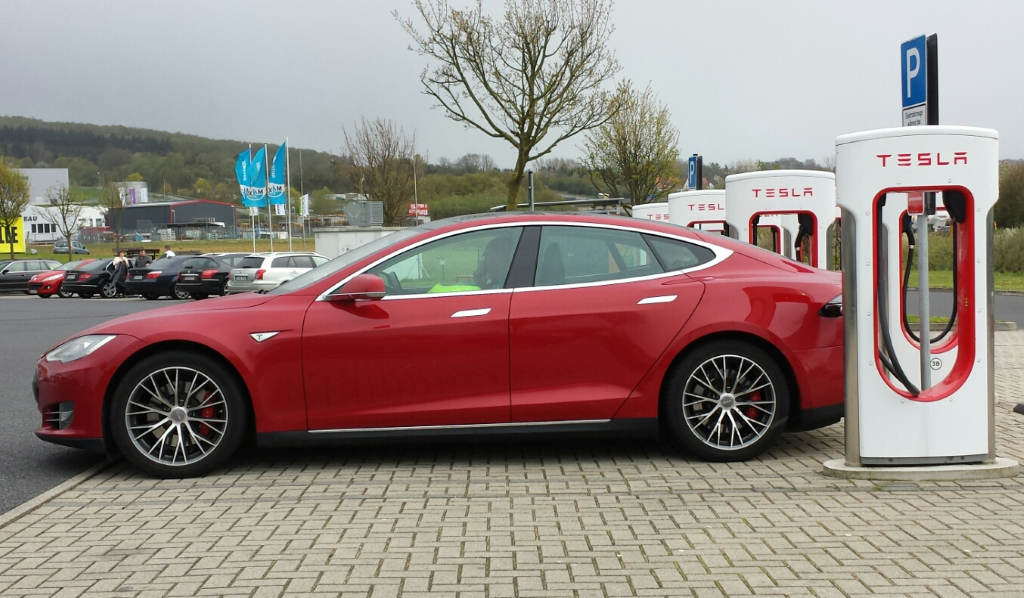I have an (IoT) dream – Tesla in front of Burger King
I took this photo on my business trip on Monday to an electric vehicle charge station. On the way back to my home I got tired and decided to stop, take a nap and to get some coffee. I left the highway and stopped in front of a Burger King. Next to my car were four Tesla charge stations. When I woke up one of the stations was in use by this nice red Tesla.
However, at my meeting for the EV charge station several problems came up.
GSM/ UMTS/LTE antenna
The designers took care to produce a beautiful enclosure. It was a big metal enclosure like the one in the photograph above. Unfortunately, designers often have no clue about embedded antennas, antenna radiation and RF electronics. If they had, then they would be antenna designers. There was no opportunity for me to place an antenna on the planar shape of the roof of the charge station. If I had, an off the shelf antenna in a sample case could do the job. For best electrical option therefore I had a no go. However, we found a good compromise by integrating the cellular antenna inside the enclosure close to the RFID reader. The next step will be a feasibility study and I am pretty sure that the proposed cellular antenna will pass. We will test the antenna on a nearly empty PCB for Return Loss as usual. I expect a directional operation because the RFID reader is not on top of the roof, but on the side of the EV charge station. I assume we will have no trouble because such charge stations are always in regions where a lot of people stay. Yesterday’s Tesla charge station is a good example. It was next to Burger King and a common gas station, and where there are people there are base stations.
eSim – SIM on chip
To avoid trouble we will use roaming SIM. Such SIM cards can register to any cellular operator. If one operator has its base station on maintenance or the whole cellular network has a blackout, then the charge station will select another cellular operator to get a connection. And if they place an EV charge station at Schwarza-Valley in the Thuringian Forest then the SIM card can look for a connection to one of our three German cellular operators. BTW, the Schwarza-Valley is my standard example for a region with cellular coverage under strange conditions.
Cellular module
The charge stations will be used in Europe and Russia only. There the frequency bands for GSM and UMTS are the same. However, we selected UMTS Penta band modules with pre radio certification on CE, FCC, GCF, PTCRB ,Anatel, RCM, IFETEL, DoC for Russia and Movistar. I gave the customer the freedom to save some cost by selecting the local version for EU or US and I showed the roadmap to LTE and NB-IoT. The cellular antenna above will cover NB-IoT, all UMTS band and all LTE bands as well. This allows the customer to migrate to LTE or NB-IoT in the future.
Next milestones in this IoT project:
Antenna pre test:
This antenna pre-test by third is just Euro 240 including documentation of Return Loss on an unmatched antenna, simulation of the matching circuit plus matching with passive components and measurement with a Vector network analyser.
- Test by VNA of the original unmatched antenna on the PCB
- Export to S1P files and export to PNG files
- Simulation of the matching circuit
- Export to S1P files and export to PNG files again
- Test report in PDF format
The pre-test will always contain the test report and the S1P file of the original PCB without matching. With the S1P file the customer of the pre-test can simulate matching circuits on their own again.
For the EV charge station we can avoid this test because we selected a cellular chip antenna we have used before. We save the costs for this and go ahead with step two.
Antenna on empty PCB inside enclosure
This test can be done in a fake enclosure made from the same plastic or in a 3D printed enclosure. In this case we can use the final enclosure. We must use the final enclosure because the designer made the decision months ago and the mould for the piece of plastic is ready. However, I expect a good compromise between design and performance.
If you have a wireless IoT / M2M project and if you have a need for the same basic advice, consulting, feasibility study, prototypes, development up to IoT devices for mass production then do not hesitate to drop and email to harald.naumann (at) gsm – modem.de .
